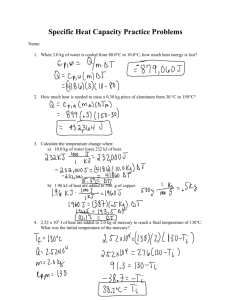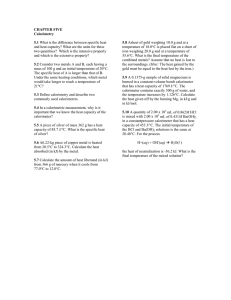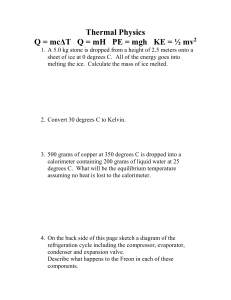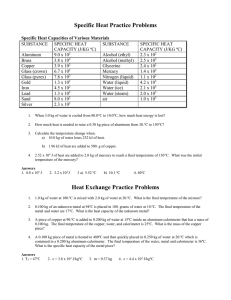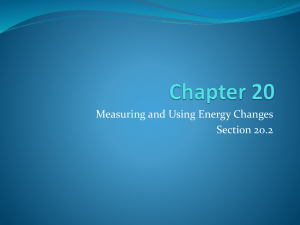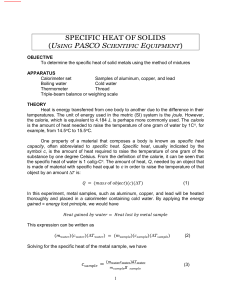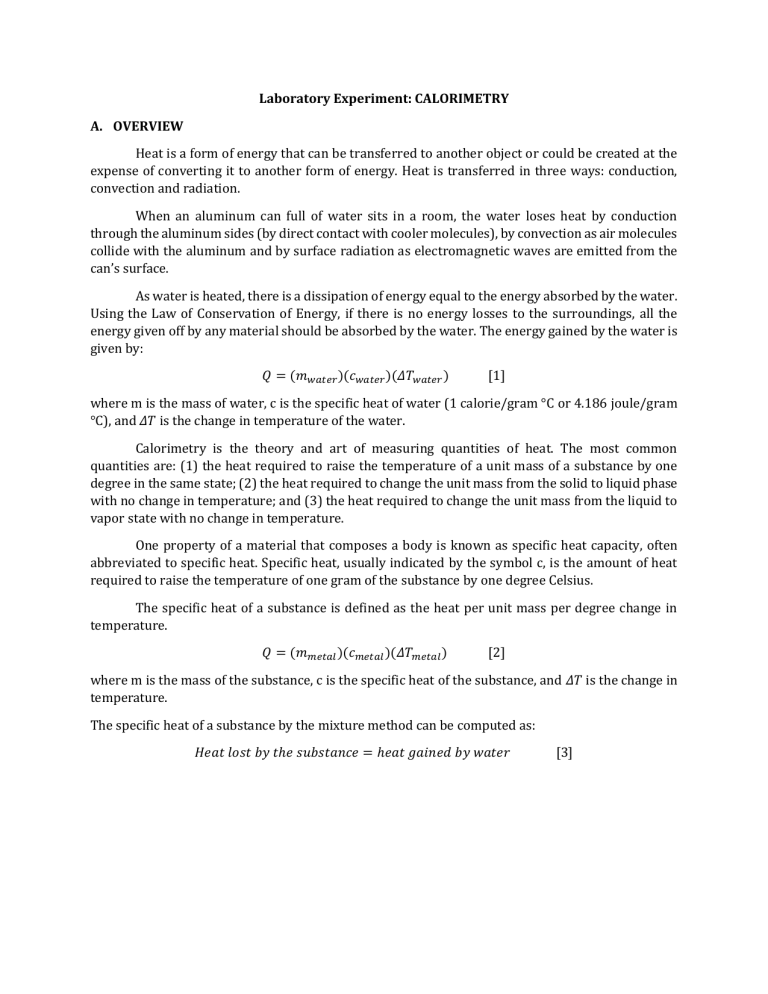
Laboratory Experiment: CALORIMETRY A. OVERVIEW Heat is a form of energy that can be transferred to another object or could be created at the expense of converting it to another form of energy. Heat is transferred in three ways: conduction, convection and radiation. When an aluminum can full of water sits in a room, the water loses heat by conduction through the aluminum sides (by direct contact with cooler molecules), by convection as air molecules collide with the aluminum and by surface radiation as electromagnetic waves are emitted from the can’s surface. As water is heated, there is a dissipation of energy equal to the energy absorbed by the water. Using the Law of Conservation of Energy, if there is no energy losses to the surroundings, all the energy given off by any material should be absorbed by the water. The energy gained by the water is given by: 𝑄 = (𝑚𝑤𝑎𝑡𝑒𝑟 )(𝑐𝑤𝑎𝑡𝑒𝑟 )(𝛥𝑇𝑤𝑎𝑡𝑒𝑟 ) [1] where m is the mass of water, c is the specific heat of water (1 calorie/gram °C or 4.186 joule/gram °C), and 𝛥𝑇 is the change in temperature of the water. Calorimetry is the theory and art of measuring quantities of heat. The most common quantities are: (1) the heat required to raise the temperature of a unit mass of a substance by one degree in the same state; (2) the heat required to change the unit mass from the solid to liquid phase with no change in temperature; and (3) the heat required to change the unit mass from the liquid to vapor state with no change in temperature. One property of a material that composes a body is known as specific heat capacity, often abbreviated to specific heat. Specific heat, usually indicated by the symbol c, is the amount of heat required to raise the temperature of one gram of the substance by one degree Celsius. The specific heat of a substance is defined as the heat per unit mass per degree change in temperature. 𝑄 = (𝑚𝑚𝑒𝑡𝑎𝑙 )(𝑐𝑚𝑒𝑡𝑎𝑙 )(𝛥𝑇𝑚𝑒𝑡𝑎𝑙 ) [2] where m is the mass of the substance, c is the specific heat of the substance, and 𝛥𝑇 is the change in temperature. The specific heat of a substance by the mixture method can be computed as: 𝐻𝑒𝑎𝑡 𝑙𝑜𝑠𝑡 𝑏𝑦 𝑡ℎ𝑒 𝑠𝑢𝑏𝑠𝑡𝑎𝑛𝑐𝑒 = ℎ𝑒𝑎𝑡 𝑔𝑎𝑖𝑛𝑒𝑑 𝑏𝑦 𝑤𝑎𝑡𝑒𝑟 [3] B. OBJECTIVE To measure the specific heat of solids by the method of mixture and compare the results with the standards. C. MATERIALS Calorimeter Metal Cylinder (Aluminum, brass and copper) Digital thermometer Beaker Weighing scale Water heater D. SET-UP Figure 1. Calorimetry set-up. E. PROCEDURES This experiment will be a Live Experiment. Pay careful attention to the live experiment demonstration conducted. Follow his experimental procedures and tick the checkbox if the live experimentalist has successfully done the specific step. □ □ □ □ □ □ □ □ Measure the mass of the metal cylinder and empty calorimeter. Fill the calorimeter with approximately ¼ amount of tap water and measure the initial temperature 𝑇𝑜𝑤𝑎𝑡𝑒𝑟 . Submerge the metal cylinder into the hot water. Measure the temperature of the hot water just before you remove the metal. Label this as the initial temperature of the metal 𝑇𝑜 𝑚𝑒𝑡𝑎𝑙 . Very quickly transfer the metal from the hot water into the calorimeter with tap water. Measure the mass of the system. Measure the final temperature of the system 𝑇𝑓 . Repeat procedures 1 to 7 with the remaining two metal cylinders. Your turn! 1. Record the data in your data table. 2. Calculate the experimental value of the specific heat of the different metals using the cponcept of law of conservation of heat. F. Data and Results Aluminum 𝑚𝑚𝑒𝑡𝑎𝑙 (kg) 𝑚𝑡𝑎𝑝 𝑤𝑎𝑡𝑒𝑟 (kg) 𝑇𝑜 𝑚𝑒𝑡𝑎𝑙 (°C) 𝑇𝑜ℎ𝑜𝑡 𝑤𝑎𝑡𝑒𝑟 (°C) 𝑇𝑓 (°C) 𝑐𝑚𝑒𝑡𝑎𝑙 (J/kg K) 𝑐𝑠𝑡𝑎𝑛𝑑𝑎𝑟𝑑 𝑣𝑎𝑙𝑢𝑒 (J/kg K) % 𝐸𝑟𝑟𝑜𝑟 G. Computations H. Analysis Copper Brass I. Conclusion J. Guide Questions 1. How would the experimental value of the specific heat be affected if some how water were carried over with the metal into the calorimeter with tap water? 2. A copper calorimeter of 100 g mass containing 200 g of water was used. The thermometer contained 0.8 cm3 of mercury and 3 g of glass. What error is introduced by neglecting the heat capacity of the thermometer? Reference: Canares A., Casquejo E., Fadri, R., Laban R., Miranda M., and Turnbull W. (2018) Physics Lab Manual
